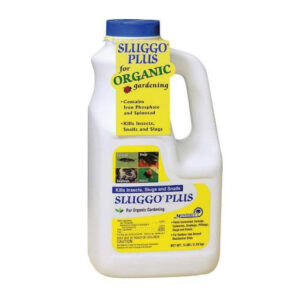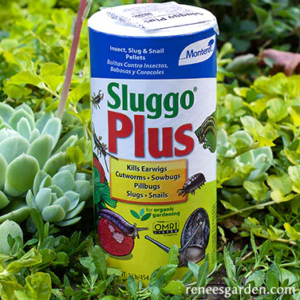HOME IMPROVEMENT
Sluggo Plus

Gardens bring beauty and joy to any space, creating a lively and refreshing atmosphere. However, they often face challenges from small insects and pests that feed on the plants. These unwanted visitors can damage the garden’s appearance and health, causing frustration for many gardeners.
Sluggo Plus is an effective option for those looking to protect their plants. This product helps manage pests while keeping gardens vibrant and thriving. Growcycle offers high-quality Sluggo Plus, known for its effectiveness against various garden pests, ensuring customers receive fresh, top-quality pest control solutions.

What is Sluggo Plus?
Sluggo Plus is a garden pest control product that targets a variety of pests, including slugs, snails, earwigs, cutworms, pillbugs, and sowbugs. It contains two active ingredients: iron phosphate, which is effective against slugs and snails, and spinosad, a natural insecticide that works on other types of insects.
Sluggo is considered safe for organic gardening and is often chosen by gardeners because it is safe for pets, wildlife, and beneficial insects like bees. It helps protect plants without posing significant risks to the surrounding environment.
How Does Sluggo Plus Work?
Sluggo Plus works by using two active ingredients, iron phosphate, and spinosad, to control a range of garden pests. Here is how each ingredient functions:
- Iron Phosphate: This compound is effective against slugs and snails. When these pests eat the bait, the iron phosphate interferes with their digestive processes, causing them to stop feeding. They then retreat into the soil and die over a few days, reducing their impact on plants.
- Spinosad: This natural insecticide targets other pests, such as earwigs, cutworms, pillbugs, and sowbugs. When these insects consume the bait or come into contact with spinosad, it affects their nervous system, causing them to stop feeding and die shortly after.
The bait in Sluggo Plus attracts pests, encouraging them to consume it instead of plants. Once ingested, it works quickly, helping protect gardens and keeping plants healthy without harming beneficial insects, pets, or the surrounding environment.

Organic Gardening Benefits of Sluggo Plus
Sluggo Plus offers several benefits for organic gardening due to its natural and environmentally friendly ingredients. Here are the key benefits:
- Pet and Wildlife Safe: The ingredients in Sluggo are safe for pets, birds, and other wildlife, making it a great choice for organic gardeners who want to avoid harming animals around the garden.
- Protects Beneficial Insects: Unlike some chemical pesticides, Sluggo Plus does not harm beneficial insects like bees, ladybugs, and other pollinators. This helps maintain a balanced ecosystem in the garden.
- OMRI-Listed: Sluggo is OMRI (Organic Materials Review Institute) listed, meaning it meets organic gardening standards. Gardeners can feel confident that it aligns with organic practices.
- Biodegradable Ingredients: The active ingredients, iron phosphate, and spinosad, break down naturally in the soil, leaving no harmful residue. This promotes soil health and doesn’t affect the long-term quality of the garden soil.
- Dual Pest Control: Sluggo Plus provides effective protection without needing multiple products by targeting a wide range of common pests, including slugs, snails, earwigs, and cutworms.
How to Apply Sluggo Plus for Effective Results?
-
Applying Sluggo Plus effectively involves a few simple steps to ensure it protects the garden without overuse. Here’s how to apply it for the best results:
-
Determine the Right Time: Apply Sluggo Plus in the late afternoon or early evening when pests are most active. This timing helps maximize the product’s effectiveness.
-
Distribute Evenly: Sprinkle Sluggo evenly around the base of plants and throughout garden beds. Focus on areas where gardeners notice pest activity or where plants are especially vulnerable.
-
Use the Correct Amount: Apply about ½ to 1 teaspoon of Sluggo Plus per square yard. Avoid piling the pellets; a light scattering is usually enough for effective pest control.
-
Reapply as Needed: Reapply every two weeks or after heavy rainfall, as rain can reduce the product’s effectiveness. Continue applications until gardeners see a noticeable reduction in pest activity.
-
Monitor Results: Check plants and the surrounding area to ensure pests are under control. Adjust the frequency of application based on pest activity to avoid overuse.
Tips and Tricks for Using Sluggo Plus
Gardeners must follow these tips to get successful results:
- Start applying Sluggo Plus at the first sign of pests to prevent infestations from growing.
- Sprinkle the product evenly around plants to ensure every pest can access it.
- Reapply after rain or irrigation to maintain its effectiveness, as water can wash it away.
- Keep it in a cool, dry place to preserve its potency for future use.
- Always follow the recommended application rates on the label for the best results.
- Monitor pest activity and adjust application frequency as necessary for ongoing protection.

Common Challenges When Using Sluggo Plus
Following are a few issues that gardeners can face while using this insecticide:
- It’s important to spread the product evenly to ensure all pests can access it. Uneven distribution may lead to persistent pest issues.
- The infestation might become harder to control if not applied early enough when pests are first noticed.
- Using too much or too little can either waste the product or lead to less-than-optimal pest control, so it’s crucial to follow application instructions.
FAQs
How often should I apply Sluggo Plus in my garden?
Sluggo should be applied once every four weeks or after heavy rain, as its rainproof formula ensures longer-lasting protection.
Is Sluggo Plus safe to use around children and pets?
Yes, Sluggo is safe for children and pets when applied as directed. The active ingredients are non-toxic to humans and animals, making it a safe option for gardens where families and pets frequently visit.
Can Sluggo Plus be used on edible plants?
Yes, Sluggo is suitable for use on edible plants and meets the standards of the National Organic Program. This means it provides effective pest control without compromising the safety of the fruits and vegetables.
The Bottom Line
The Sluggo Plus is a new, eco-friendly way to control pests. Its two-in-one formula offers strong protection, making it a helpful tool for any gardener. Sluggo is a great choice for gardeners wanting to improve their health while staying organic.
Growcycle supplies this effective pest control product at a good price for those looking for Sluggo Plus. Known for excellent customer service and fair pricing, Growcycle makes it easy for gardeners to get this product whenever needed.
HOME IMPROVEMENT
How to Integrate Grounding Sheets into Your Natural Home Setup

If you’re someone who loves creating a cozy, natural home, you might have heard about grounding sheets. These special bed sheets are designed to connect you to the Earth’s natural energy, even while you’re sleeping. They’re becoming popular among people who want to live closer to nature and boost their health in simple ways. In this article, we’ll explore what grounding sheets are, why they’re a great addition to a natural home, and how you can easily bring them into your daily life. We’ll also share practical tips to make sure they fit perfectly into your eco-friendly Natural Home setup.
What Are Grounding Sheets?
Grounding sheets, sometimes called earthing bed sheets woven with conductive materials like silver or carbon fibers. These materials help your body connect to the Earth’s natural electric charge, kind of like walking barefoot on grass or sand. The sheets plug into the grounding port of an electrical outlet in your home, which is connected to the Earth. Don’t worry—this doesn’t involve electricity running through the sheets. It’s just a safe way to let the Earth’s energy flow to you while you sleep.
The idea behind grounding comes from the belief that our bodies can benefit from being in touch with the Earth. In the past, people spent a lot of time walking barefoot or sleeping on natural surfaces, which kept them connected to the planet’s energy. Today, with rubber-soled shoes and modern homes, we’re often cut off from this natural connection. Grounding sheets help bring that connection back, right in the comfort of your bedroom.
Organic grounding sheet take this a step further. They’re made from natural materials like organic cotton, which is grown without harmful pesticides or chemicals. This makes them a perfect fit for anyone who values a healthy, eco-friendly lifestyle. By choosing organic grounding sheets, you’re not only helping your body but also supporting sustainable practices that are kinder to the planet.
Why Add Grounding Sheets to Your Natural Home?
A natural home is all about creating a space that feels healthy, calm, and in tune with nature. Grounding sheets fit right into this idea. Here’s why they’re a great addition:
- Better Sleep: Many people say grounding sheets help them sleep deeper and wake up feeling more refreshed. Studies suggest that grounding can lower stress hormones like cortisol, which might help you relax and sleep better. In a natural home, where rest and relaxation are key, this is a big win.
- Less Stress and Inflammation: Some research shows that grounding can reduce inflammation in the body by neutralizing free radicals. This could help with things like muscle aches or joint pain. For those living a natural lifestyle, grounding sheets offer a drug-free way to support wellness.
- Eco-Friendly Materials: Organic grounding sheets are made with sustainable materials like organic cotton. They’re free from harmful chemicals, which aligns with the values of a natural home. Plus, they’re often made with ethical practices, supporting fair wages and environmentally friendly production.
- Connection to Nature: Even if you live in a city, grounding sheets let you tap into the Earth’s energy without leaving your bedroom. It’s like bringing a little piece of nature indoors, which is perfect for anyone trying to create a more grounded, peaceful home.
- Simple to Use: Grounding sheets are easy to set up and care for, making them a low-effort addition to your natural home. They blend seamlessly with your existing bedding, so you don’t have to overhaul your bedroom to use them.
How to Choose the Right Grounding Sheets
Before you bring grounding sheets into your home, it’s important to pick the right ones. Here are some tips to help you choose:
- Look for Organic Materials: If you’re committed to a natural home, go for organic grounding sheets. Check for certifications like GOTS (Global Organic Textile Standard) or OEKO-TEX, which ensure the sheets are made from organic cotton and free from harmful chemicals.
- Check the Conductive Material: Most grounding sheets use silver or carbon fibers to conduct the Earth’s energy. Silver is popular because it’s highly conductive and has natural antibacterial properties, which is great for keeping your sheets fresh.
- Pick the Right Size: Grounding sheets come in sizes like twin, queen, or king to fit your bed. Make sure to measure your mattress to get a snug fit. Some sheets are fitted, while others are flat, so choose what works best for your bedding setup.
- Read Reviews: Look for feedback from other users to see how the sheets hold up over time. High-quality grounding sheets should stay conductive even after washing, so check what people say about durability.
- Safety Features: Good grounding sheets come with a grounding cord that has a built-in resistor for safety. This limits any unexpected electrical flow, making the sheets safe to use. Also, make sure the sheets come with an outlet tester to check that your home’s grounding port is working properly.
Setting Up Grounding Sheets in Your Bedroom
Adding grounding sheets to your natural home is super easy. Here’s a step-by-step guide to get you started:
- Check Your Outlet: Most grounding sheets connect to the grounding port of a standard electrical outlet. Before you set up your sheets, use an outlet tester (often included with the sheets) to make sure your outlet is properly grounded. This ensures the sheets will work as intended.
- Prepare Your Bed: If you’re using a fitted grounding sheet, place it directly on your mattress, just like a regular fitted sheet. If it’s a flat sheet, you can lay it over your fitted sheet or under a thin layer of natural fabric, like a cotton top sheet. For the best results, your skin should touch the grounding sheet directly, so avoid thick layers between you and the sheet.
- Connect the Grounding Cord: Snap one end of the grounding cord onto the metal stud or strip on the sheet. Plug the other end into the grounding port of your outlet. This port is the round hole in a standard U.S. outlet—it’s completely safe and doesn’t carry electricity.
- Test the Setup: Some grounding sheets come with instructions to test conductivity using a multimeter. If you have one, you can check that the sheet is properly connected by measuring resistance. A reading of around 100 kiloohms usually means everything is working.
- Style Your Bed: Grounding sheets come in neutral colors like white or gray, so they blend easily with your existing bedding. Pair them with organic cotton pillowcases, a natural fiber blanket, or a sustainable bamboo duvet cover to keep your bedroom looking cohesive and eco-friendly.
Caring for Your Grounding Sheets
To keep your grounding sheets working well and lasting a long time, you’ll need to care for them properly. Here’s how to do it:
- Wash Regularly: Like any bed sheets, grounding sheets can collect sweat and skin oils, which might affect their conductivity. Wash them every one to two weeks. Use a mild, natural detergent that’s free from bleach, fabric softeners, or oils like lavender or coconut. These can damage the conductive fibers.
- Machine or Hand Wash: Most grounding sheets can be machine-washed on a gentle cycle with warm or cold water. If you want to be extra careful, hand-washing is a great option. Always check the manufacturer’s instructions first.
- Dry Carefully: Air-drying is best for grounding sheets, as it helps preserve the conductive fibers. If you use a dryer, set it to low heat and skip the dryer sheets, which can leave a residue that reduces conductivity.
- Avoid Lotions Before Bed: Try not to apply heavy lotions or body oils right before sleeping on your grounding sheets. These can build up on the fabric and affect how well the sheets work.
- Store Properly: When not in use, store your grounding sheets in a dry, cool place. Keep them away from harsh chemicals or cleaning products that could damage the fibers.
Integrating Grounding Sheets into Your Natural Lifestyle
Grounding sheets are just one part of a natural home, but they work even better when paired with other eco-friendly habits. Here are some ideas to make them part of your holistic lifestyle:
- Create a Calming Bedroom: A natural home is all about peace and simplicity. Use soft, earthy colors like greens, browns, or blues in your bedroom to complement your grounding sheets. Add plants like a peace lily or snake plant to clean the air and bring nature indoors.
- Practice Grounding Outdoors: While grounding sheets are great for indoor use, spending time barefoot outside can boost the benefits. Try walking on grass, dirt, or sand for 20–30 minutes a few times a week. This pairs perfectly with the grounding you get from your sheets at night.
- Combine with Mindfulness: Grounding is about connecting to the Earth, and mindfulness practices like meditation or deep breathing can enhance that connection. Try a short meditation session on your grounding sheets before bed to relax your mind and body.
- Choose Sustainable Bedding: Pair your organic grounding sheets with other eco-friendly bedding, like organic cotton or linen pillowcases and blankets. Look for products made with fair-trade practices to support ethical production.
- Reduce EMF Exposure: Grounding sheets may help reduce the effects of electromagnetic fields (EMFs) from devices like phones or Wi-Fi routers. To go further, keep electronics out of your bedroom or turn off Wi-Fi at night to create a low-EMF sleep environment.
Common Questions About Grounding Sheets
If you’re new to grounding sheets, you might have some questions. Here are answers to some common ones:
- Are grounding sheets safe? Yes, grounding sheets are safe when used correctly. They connect to the grounding port of an outlet, which doesn’t carry electricity. Always test your outlet with an outlet tester to make sure it’s properly grounded.
- Do they really work? Some studies suggest grounding can improve sleep, reduce stress, and lower inflammation, but results vary from person to person. Many users report feeling more rested and less achy, but it might take a few weeks to notice changes. The placebo effect could also play a role, but even if it’s partly psychological, better sleep is still a win!
- Can I use them with regular sheets? Yes, but for the best results, your skin should touch the grounding sheet directly. If you want to use a top sheet, choose a thin, natural material like organic cotton to allow the electrons to flow.
- How long do they last? With proper care, grounding sheets can last for years. The conductive fibers might wear down over time, but washing them gently and avoiding harsh detergents helps them stay effective.
- Can my pets use them? Pets can benefit from grounding sheets, too! Many people notice their dogs or cats love sleeping on them. Just make sure the sheets stay clean and the grounding cord is out of reach to avoid chewing.
Tips for Getting the Most Out of Grounding Sheets
To make sure your grounding sheets work as well as possible, try these tips:
- Be Consistent: Use your grounding sheets every night to get the full benefits. Some people feel a difference right away, while others need a few weeks to notice changes.
- Test Your Setup: If you’re not sure your sheets are working, use a multimeter to check conductivity. This can give you peace of mind that your grounding system is set up correctly.
- Combine with a Healthy Routine: Pair your grounding sheets with other healthy habits, like drinking plenty of water, eating whole foods, and getting regular exercise. This can amplify the benefits of grounding.
- Listen to Your Body: Everyone’s experience with grounding is different. Pay attention to how you feel—do you sleep better, feel less stressed, or have more energy? Keep a journal to track any changes over time.
- Involve Your Family: If you share your bed with a partner or have kids, consider getting grounding sheets for everyone. They come in all bed sizes, so you can outfit your whole household for better sleep and wellness.
Making Your Natural Home Even Better
Grounding sheets are a simple, effective way to bring the benefits of nature into your home. By choosing organic grounding sheets, you’re not only supporting your health but also making a choice that’s good for the planet. They’re easy to use, fit seamlessly into your bedroom, and work well with other natural living practices. Whether you’re looking to sleep better, reduce stress, or feel more connected to the Earth, grounding sheets are a great addition to your natural home setup.
Start by picking a high-quality set of organic grounding sheets, setting them up properly, and caring for them with eco-friendly practices. Pair them with other natural elements in your bedroom, like plants or sustainable bedding, to create a space that feels calm and restorative. With a little effort, you can turn your bedroom into a haven that supports both your health and the environment. So why not give grounding sheets a try? They might just be the missing piece to making your natural home even more nurturing and peaceful.
HOME IMPROVEMENT
10 Stylish Door Knobs to Elevate Your Home’s Aesthetic

When it comes to home decor, the smallest details can make the biggest difference. Door knobs, often overlooked, are one of those subtle yet impactful elements that can transform the look and feel of your home. A stylish door knobs doesn’t just serve a functional purpose—it adds personality, enhances your interior design, and ties together the aesthetic of any room. Whether you’re refreshing a single space or giving your entire home a makeover, choosing the right door knob can elevate your home’s charm. At Handles4U, you’ll find an impressive range of door knobs to suit every style and budget. Here are 10 stylish door knobs to inspire your next home upgrade.
1. Sleek Matte Black Door Knobs
Matte black finishes have taken the interior design world by storm, and for good reason. These door knobs exude modern sophistication, making them perfect for minimalist or industrial-style homes. Their understated elegance pairs beautifully with white walls, wooden textures, or bold accent colors. Opt for a matte black knob with clean lines for a contemporary look that feels both timeless and trendy.
Why it works: The bold contrast of matte black adds a touch of drama without overwhelming the space, ideal for entryways or living rooms.
2. Polished Chrome Knobs for a Modern Edge
If you’re aiming for a sleek, futuristic vibe, polished chrome door knobs are a fantastic choice. Their reflective surface catches the light, adding a touch of glamour to any room. These knobs work particularly well in homes with modern or Scandinavian-inspired decor, where clean lines and metallic accents reign supreme.
Why it works: Chrome knobs are versatile, complementing both light and dark color palettes while adding a polished finish to your doors.
3. Vintage-Inspired Brass Knobs
For a touch of nostalgia, vintage brass door knobs bring warmth and character to your home. Their aged, golden hue is perfect for traditional, farmhouse, or eclectic interiors. Look for knobs with intricate detailing or a slightly worn patina to enhance the old-world charm.
Why it works: Brass knobs add a cozy, inviting feel, making them a great fit for bedrooms or cozy reading nooks.
4. Crystal Glass Knobs for Timeless Elegance
Nothing says luxury like a crystal glass door knob. These sparkling beauties refract light, creating a dazzling effect that elevates any space. Ideal for period homes or rooms with a touch of vintage glamour, crystal knobs add a sense of opulence without being over-the-top.
Why it works: Their reflective quality makes them a stunning focal point, especially in dining rooms or bathrooms.
5. Rustic Iron Knobs for a Farmhouse Feel
Rustic iron door knobs are a must for anyone embracing the farmhouse or cottagecore aesthetic. Their rugged texture and dark, earthy tones bring a sense of authenticity to your home. Pair them with wooden doors or exposed brick walls for a cozy, lived-in vibe.
Why it works: Iron knobs add a handcrafted, artisanal touch that feels warm and welcoming in kitchens or entryways.
6. Geometric Knobs for a Bold Statement
For those who love to push design boundaries, geometric door knobs are a game-changer. Think hexagonal, octagonal, or faceted shapes that add a modern, architectural flair. These knobs are perfect for homeowners who want their hardware to stand out as a conversation piece.
Why it works: Geometric knobs bring a contemporary edge to minimalist or eclectic spaces, especially in home offices or creative studios.
7. Satin Nickel Knobs for Understated Sophistication
Satin nickel door knobs strike the perfect balance between modern and classic. Their soft, brushed finish is subtle yet stylish, making them a versatile choice for nearly any room. They blend seamlessly with neutral tones, wood accents, or even bold color schemes.
Why it works: Satin nickel is low-maintenance and timeless, ideal for high-traffic areas like hallways or children’s rooms.
8. Ceramic Knobs for a Pop of Color
Add a splash of personality with ceramic door knobs. Available in a range of colors—from soft pastels to vibrant jewel tones—these knobs are perfect for injecting fun into your decor. They’re especially suited for bohemian or eclectic homes where color and texture reign supreme.
Why it works: Ceramic knobs bring a playful, artistic vibe to nurseries, guest rooms, or creative spaces.
9. Knurled Texture Knobs for Tactile Appeal
Knurled door knobs, with their textured, cross-hatched surface, are a rising trend in 2025. The tactile quality of these knobs adds a layer of sophistication while providing a better grip. They’re perfect for modern or industrial spaces where functionality meets style.
Why it works: The unique texture makes knurled knobs a standout feature in bathrooms or kitchens, where practicality is key.
10. Rose Gold Knobs for a Touch of Glam
Rose gold door knobs are the epitome of chic, offering a warm, metallic glow that feels both luxurious and approachable. These knobs are perfect for homeowners who want to add a hint of glamour without going overboard. Pair them with soft pinks, grays, or whites for a cohesive look.
Why it works: Rose gold adds a trendy, feminine touch to bedrooms, dressing rooms, or stylish home offices.
Tips for Choosing the Perfect Door Knob
With so many stylish options, how do you choose the right door knob for your home? Here are a few tips to guide you:
- Match Your Aesthetic: Ensure the knob aligns with your home’s overall style, whether it’s modern, traditional, or eclectic.
- Consider Functionality: For high-traffic areas, opt for durable materials like stainless steel or brass that can withstand daily use.
- Think About Finishes: Coordinate your door knobs with other hardware, like cabinet handles or light fixtures, for a cohesive look.
- Test the Feel: A door knob should feel comfortable in your hand and operate smoothly.
- Budget Wisely: At Handles4U, you’ll find high-quality door knobs, internal door handles at various price points, so you can elevate your home without breaking the bank.
Why Door Knobs Matter
You might wonder why something as small as a door knob deserves so much attention. The answer lies in the details. Door knobs are one of the most frequently used elements in your home, and their design can subtly influence the atmosphere of a space. A well-chosen knob can make a room feel more inviting, luxurious, or cohesive. Plus, updating your door knobs is a budget-friendly way to refresh your home without committing to a full renovation.
Shop Stylish Door Knobs at Handles4U
Ready to elevate your home’s aesthetic? At Handles4U, you’ll find a wide selection of door knobs to suit every taste and style. From sleek modern designs to vintage-inspired classics, their collection is curated to help you find the perfect hardware for your home. Browse their range today and discover how a simple door knob can make a big impact.
Final Thoughts
Your home deserves to shine, and stylish door knobs are an easy way to add personality and flair. Whether you’re drawn to the timeless elegance of crystal glass, the bold modernity of matte black, or the cozy charm of vintage brass, there’s a door knob out there to match your vision. Explore the possibilities, experiment with textures and finishes, and let your doors become a canvas for your unique style. With the right door knobs, every room in your home can feel like a masterpiece.
HOME IMPROVEMENT
Increase Your Home’s Worth: Essential Plumbing Improvements

Why Plumbing Upgrades Matter
Home improvements are essential for increasing the comfort and value of your property. While many think of kitchen redesigns or landscaping, plumbing upgrades often fly under the radar. Yet, they are crucial for enhancing functionality and raising a home’s market value. Plumbing improvements create a ripple effect of benefits, from improved daily living to attracting discerning buyers when it’s time to sell. Comprehensive upgrades can lead to lower utility bills, superior conveniences, and even a higher resale value, making them a strategic investment for homeowners who wish to enhance their property’s appeal.
Investing in quality water heater repair and similar systems within your home is one of the smartest moves you can make. Efficient fixtures and modern plumbing systems have become key selling points, offering unprecedented energy conservation paired with long-term cost savings. Buyers increasingly seek homes that commit to sustainability, and plumbing upgrades contribute significantly to this goal by providing future-proof solutions that align with modern environmental concerns.
Smart Bathroom Fixtures
Smart technology has started a new age in residential utilities, transforming everyday routines and raising living standards. Implementing smart fixtures in the bathroom provides both an aesthetic revamp and practical gains. Motion-activated faucets, self-cleaning toilets, and high-efficiency showerheads offer unprecedented convenience, conservation, and customization. These advancements mean a bathroom can be functional, delivering the highest utility while using the least resources.
These smart solutions should be on the checklist for homeowners working with a remodel contractor. They enhance the bathroom experience and substantially increase your home’s attractiveness to future buyers looking for contemporary, hassle-free living spaces that act as eco-friendly sanctuaries.
Efficient Water Heaters
Heating water represents a significant household energy expense, accounting for about 18% of a home’s total energy use. Upgrading to an efficient water heater can significantly reduce these costs. Modern water heaters are designed to heat water more effectively, resulting in less energy waste and lower utility bills. Tankless models, for example, provide hot water on demand, eliminating the standby energy losses associated with traditional tank systems. These units also offer the convenience of a continuous hot water supply without needing a large storage tank.
Expert advice is essential when optimizing your water heating system. Professionals can evaluate your specific needs and recommend the best solution. They also ensure that installations comply with safety standards and local regulations, helping maintain your home’s security and efficiency.
Kitchen Upgrades
The kitchen is often seen as the heart of a home, a centerpiece where families gather to cook, eat, and socialize. Consequently, the functionality of this space is a top priority for homeowners. Plumbing upgrades can significantly expand the kitchen’s utility and ease of use. Features such as pot fillers save you from making several trips between the sink and the stove, cutting down on time and effort. Adding a secondary sink in large or multi-functional kitchens can alleviate congestion during meal prep and cleaning.
These enhancements showcase forward-thinking in kitchen design, integrating practicality with innovative solutions that keep pace with current trends in efficiency. Updating kitchen plumbing ensures your culinary space meets modern standards and caters to future needs. This not only enhances your personal cooking experience but also serves as a compelling draw for potential buyers.
Eco-Friendly Systems
Integrating eco-friendly plumbing systems can set your home apart in an era where sustainability is becoming the norm. Not only do these systems help reduce your environmental footprint, but they also add significant market value to your home by attracting environmentally conscious buyers. Low-flow toilets, faucet aerators, and rainwater collection systems reflect a dedication to resource conservation. Buyers increasingly value homes that offer such features, understanding the long-term benefits, which extend to reduced water bills and energy savings.
Sustainable plumbing choices represent a sound investment that brings immediate and lasting benefits. Adopting these systems secures the environment’s future and enhances your living comfort and property value.
Consulting Professionals
Having professional knowledge is crucial for a successful plumbing renovation. Homeowners should look for experienced consultants who can guide them through the complexities of product choices, installations, and inspections. Specialists ensure that all upgrades are executed to the highest standards and within the scope of local building codes, thus avoiding costly redesigns or corrections down the line.
Engaging with professionals offers valuable perspectives on the best materials, designs, and technologies suited to particular needs and ambitions. It guarantees a seamless upgrade process, culminating in a home that is as functionally efficient as it is aesthetically pleasing. Thus, each dollar spent will maximize comfort, energy savings, and future resale value.
-

 HEALTH2 years ago
HEALTH2 years agoIntegrating Semaglutide into Your Weight Loss Plan: A Practical Guide
-

 HOME IMPROVEMENT2 years ago
HOME IMPROVEMENT2 years agoHow to Choose the Perfect Neutral Area Rug for Every Room
-

 LAW1 year ago
LAW1 year agoTeenage Drivers and Car Accidents in California: Risks and Parental Liability
-

 CONSTRUCTION1 year ago
CONSTRUCTION1 year agoConstruction Site Safety Regulations in New York and Your Rights as a Worker
-

 LAW1 year ago
LAW1 year agoPost-Divorce Considerations in California: Modifications and Long-Term Planning
-

 HOME2 years ago
HOME2 years agoSandra Orlow: The Teen Model Who Captivated the Internet
-

 FINANCE1 year ago
FINANCE1 year agoDigital Asset Management in Florida Estate Planning
-

 LAW1 year ago
LAW1 year agoKentucky’s School Football: Concussions, Injuries, and Legal Options
